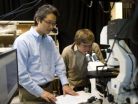(Press-News.org) During a total eclipse of the Sun, skywatchers are awed by the shimmering corona -- a faint glow that surrounds the Sun like gossamer flower petals. This outer layer of the Sun's atmosphere is, paradoxically, hotter than the Sun's surface, but so tenuous that its light is overwhelmed by the much brighter solar disk. The corona becomes visible only when the Sun is blocked, which happens for just a few minutes during an eclipse.
Now, an instrument on board NASA's Solar Dynamics Observatory (SDO), developed by Smithsonian scientists, is giving unprecedented views of the innermost corona 24 hours a day, 7 days a week.
"We can follow the corona all the way down to the Sun's surface," said Leon Golub of the Harvard-Smithsonian Center for Astrophysics (CfA).
Previously, solar astronomers could observe the corona by physically blocking the solar disk with a coronagraph, much like holding your hand in front of your face while driving into the setting Sun. However, a coronagraph also blocks the area immediately surrounding the Sun, leaving only the outer corona visible.
The Atmospheric Imaging Assembly (AIA) instrument on SDO can "fill" this gap, allowing astronomers to study the corona all the way down to the Sun's surface. The resulting images highlight the ever-changing connections between gas captured by the Sun's magnetic field and gas escaping into interplanetary space.
The Sun's magnetic field molds and shapes the corona. Hot solar plasma streams outward in vast loops larger than Earth before plunging back onto the Sun's surface. Some of the loops expand and stretch bigger and bigger until they break, belching plasma outward.
"The AIA solar images, with better-than-HD quality views, show magnetic structures and dynamics that we've never seen before on the Sun," said CfA astronomer Steven Cranmer. "This is a whole new area of study that's just beginning."
Cranmer and CfA colleague Alec Engell developed a computer program for processing the AIA images above the Sun's edge. These processed images imitate the blocking-out of the Sun that occurs during a total solar eclipse, revealing the highly dynamic nature of the inner corona. They will be used to study the initial eruption phase of coronal mass ejections (CMEs) as they leave the Sun and to test theories of solar wind acceleration based on magnetic reconnection.
INFORMATION:
SDO is the first mission and crown jewel in a fleet of NASA missions to study our sun. The mission is the cornerstone of a NASA science program called Living with a Star, the goal of which is to develop the scientific understanding necessary to address those aspects of the sun-Earth system that directly affect our lives and society. Goddard Space Flight Center built, operates, and manages the SDO spacecraft for NASA's Science Mission Directorate in Washington.
Smithsonian instrument 'fills the gap,' views sun's innermost corona
2011-01-06
ELSE PRESS RELEASES FROM THIS DATE:
Clinical practitioners not adhering to evidence-based guidelines for osteoarthritis
2011-01-06
New research found clinicians who care for patients with osteoarthritis (OA) are likely not following standard care guidelines that are based on current medical evidence. Researchers noted physicians were prescribing medications for pain and inflammation, or opting for surgical interventions rather than recommending weight loss plans or exercise programs to OA patients. Details of the this study are available in the January 2011 issue of Arthritis Care & Research, a journal published by Wiley-Blackwell on behalf of the American College of Rheumatology.
A 2002 report ...
New solar cell self-repairs like natural plant systems
2011-01-06
WEST LAFAYETTE, Ind. - Researchers are creating a new type of solar cell designed to self-repair like natural photosynthetic systems in plants by using carbon nanotubes and DNA, an approach aimed at increasing service life and reducing cost.
"We've created artificial photosystems using optical nanomaterials to harvest solar energy that is converted to electrical power," said Jong Hyun Choi, an assistant professor of mechanical engineering at Purdue University.
The design exploits the unusual electrical properties of structures called single-wall carbon nanotubes, using ...
Wake up and smell the willow
2011-01-06
More plant matter could be burned in coal-fired power stations if this 'green' fuel was delivered pre-roasted like coffee beans, according to researchers from the University of Leeds, UK.
Many UK power stations are now burning plant matter, or biomass, as well as coal in a bid to cut their carbon footprint. Unlike fossil fuels, plants like willow, Miscanthus and poplar are a virtually carbon-neutral source of energy: the carbon dioxide emitted when they burn is absorbed during photosynthesis by the next batch of 'energy crops' planted in their place.
But the environmental ...
US does not have infrastructure to consume more ethanol
2011-01-06
WEST LAFAYETTE, Ind. - The United States doesn't have the infrastructure to meet the federal mandate for renewable fuel use with ethanol but could meet the standard with significant increases in cellulosic and next-generation biofuels, according to a Purdue University study.
Wally Tyner, the James and Lois Ackerman Professor of Agricultural Economics, and co-authors Frank Dooley, a Purdue professor of agricultural economics, and Daniela Viteri, a former Purdue graduate student, used U.S. Department of Energy and Environmental Protection Agency data to determine that the ...
Environmental Science & Technology special issue on environmental policy now online
2011-01-06
WASHINGTON, Jan. 4, 2011 — A special edition of the American Chemical Society journal, Environmental Science & Technology (ES&T), one of the world's premier environmental journals, is available now for a limited time online without charge. The special edition will be accessible free during 2011, when the world celebrates the International Year of Chemistry.
Entitled "Environmental Policy: Past, Present, and Future," the special issue of ES&T recognizes closure of a "green" decade in which people became more aware of environmental issues, and society marked the 40th anniversaries ...
Vaccine blocks cocaine high in mice
2011-01-06
NEW YORK (Jan. 4, 2011) — Researchers have produced a lasting anti-cocaine immunity in mice by giving them a safe vaccine that combines bits of the common cold virus with a particle that mimics cocaine.
In their study, published Jan. 4 in the online edition of Molecular Therapy and funded by the National Institute on Drug Abuse, the researchers say this novel strategy might be the first to offer cocaine addicts a fairly simple way to break and reverse their habit, and it might also be useful in treating other addictions, such as to nicotine, heroin and other opiates.
...
VCU findings may help explain some major clinical symptoms of preeclampsia
2011-01-06
RICHMOND, Va. (Jan. 4, 2011) – Virginia Commonwealth University School of Medicine researchers have found that a significant increase of an enzyme in the blood vessels of pregnant women with preeclampsia may explain some of the symptoms associated with the condition, including hypertension, swelling and protein in the urine.
The findings could lead to a treatment for pregnant women with preeclampsia, which is one of the most significant health problems in pregnancy and a leading cause worldwide of both premature delivery and of sickness and death of the mother and baby.
Preeclampsia, ...
Scientists discover that a specific enzyme inhibitor may help control lung inflammation
2011-01-06
All of us may be able to breathe a little easier now that scientists from Pennsylvania have found a new therapeutic target for controlling dangerous inflammation in the lungs. A new research report in the January 2011 issue of the Journal of Leukocyte Biology (http://www.jleukbio.org) suggests that blocking the activation of an enzyme called delta-protein kinase C (delta-PKC) could protect the lungs from neutrophil-mediated damage, which can result in out of control inflammation. In an animal model of acute respiratory distress syndrome (ARDS), inhibiting delta-PKC in ...
A new drug target in atherosclerosis: The anaphylatoxin C5a
2011-01-06
For decades, doctors have looked at fitness levels, weight, and overall health risk factors for heart disease and stroke. Now, they may soon add a new risk factor to the list: activation of the complement system. The complement system is usually implicated in immune responses, but now there's a role for it in cardiovascular disease. In a new research report appearing in the January 2011 print issue of the FASEB Journal (http://www.fasebj.org), scientists from Europe and the United States show that anaphylatoxin C5a, a protein released when complement is activated, contributes ...
Mercyhurst pioneers game-based learning in teaching strategic intelligence
2011-01-06
Kris Wheaton pushes a key on his computer and the reminder transmits to dozens of intelligence studies students: Game Lab Tonight!
Himself a long-time gamer, Wheaton is a pioneer in game-based learning as it applies to the teaching of intelligence analysis.
Whether wrangling over the next move in "Defiant Russia," a board game based on the 1941 German attack on the Soviet Union, where players control the units that fought in the campaign; or strategizing over the online musical puzzle journey that is "Auditorium," there's lots of learning going on.
"In terms of ...


